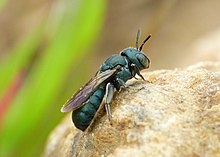Ceratina
|
Ceratina Temporal range: 37–0 Ma |
|
|---|---|
 |
|
| Ceratina sp. | |
| Scientific classification | |
| Kingdom: | Animalia |
| Phylum: | Arthropoda |
| Class: | Insecta |
| Order: | Hymenoptera |
| Family: | Apidae |
| Tribe: | Ceratinini |
| Genus: |
Ceratina Latreille, 1802 |
| Species | |
|
>200 species |
|
>200 species
The cosmopolitan bee genus Ceratina, often referred to as small carpenter bees, is the sole lineage of the tribe Ceratinini, and closely related to the more familiar carpenter bees. They make nests in dead wood, stems, or pith, and while many are solitary, a number are subsocial, with mothers caring for their larvae, and in a few cases where multiple females are found in a single nest, daughters or sisters may form very small, weakly eusocial colonies (where one bee forages and the other remains in the nest and lays eggs). One species is unique for having both social and asocial populations, Ceratina australensis, which exhibits all of the pre-adaptations for successful group living. This species is socially polymorphic with both solitary and social nests collected in sympatry. Social colonies in that species consist of two foundresses, one contributing both foraging and reproductive effort and the second which remains at the nest as a passive guard. Cooperative nesting provides no overt reproductive benefits over solitary nesting in this population, although brood survival tends to be greater in social colonies. Maternal longevity, subsociality and bivoltine nesting phenology in this species favour colony formation, while dispersal habits and offspring longevity may inhibit more frequent social nesting in this and other ceratinines.
Ceratina are commonly dark, shining, even metallic bees, with fairly sparse body hairs and a weak scopa on the hind tibia. Most species have some yellow markings, most often restricted to the face, but often elsewhere on the body. They are very commonly mistaken for "sweat bees" (family Halictidae), due to their small size, metallic coloration, and some similarity in wing venation; they can be easily separated from halictids by the mouthparts (with a long glossa) and the hindwings (with a tiny jugal lobe).
A few species are exceptional among bees in that they are parthenogenetic, reproducing without males.
...
Wikipedia
